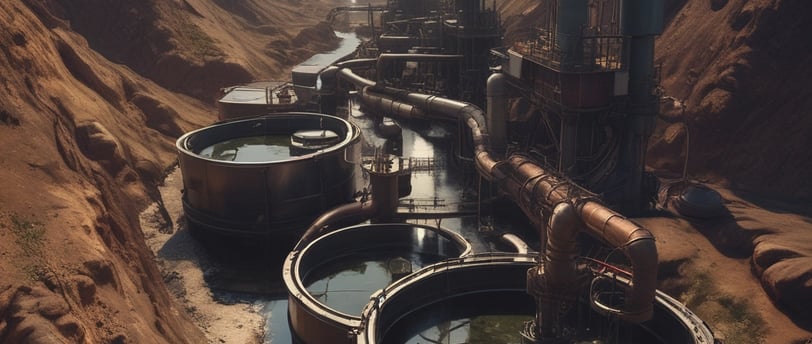convert oil sludge into pyrolysis oil l: A Sustainable Approach
Learn how to convert oil sludge into pyrolysis oil with eco-friendly technology. Reduce waste, recover energy & support sustainability with this innovative process.
Veera group Author
7/15/20255 min read


Understanding Oil Sludge: Its Composition and Challenges
Oil sludge is a complex mixture primarily composed of hydrocarbons, water, and solid particulates that arise during the production, refining, and transportation of crude oil and its derivatives. This viscous substance can vary significantly in composition depending on its source, but it typically contains a range of organic compounds, including heavy metals, asphaltenes, and various volatile organic compounds (VOCs). Oil sludge's heterogeneous nature poses considerable challenges, both in terms of its management and its environmental impact.
The origins of oil sludge can be traced primarily to the oil and gas industry, where it is generated as a byproduct of drilling operations, refining processes, and the transportation of crude oil. In drilling, for example, oil sludge can accumulate in the cuttings, while during refining, it may be produced from the separation processes or equipment maintenance. Moreover, oil sludge can also result from operational issues such as leaks or spills, further complicating its management.
The environmental challenges posed by oil sludge are multifaceted. Firstly, its disposal can lead to soil and water contamination, affecting ecosystems and human health. The hazardous components within the sludge, including heavy metals, have the potential to leach into the surrounding environment, causing long-term damage. Secondly, the treatment and disposal of oil sludge remain costly and technically challenging, often requiring specialized facilities and processes. Furthermore, existing disposal methods, such as landfilling or incineration, may not sufficiently mitigate the environmental risks associated with oil sludge, leading to ongoing calls for more sustainable solutions.
Understanding the chemical composition and the challenges linked to oil sludge emphasizes the urgent need for effective management strategies. Innovative solutions, such as pyrolysis, provide a promising avenue for transforming this problematic waste into valuable resources, thus addressing both environmental concerns and the quest for sustainable energy alternatives.
The Pyrolysis Process: Step-by-Step Breakdown
The pyrolysis process is a thermal decomposition method used to convert organic materials, such as oil sludge, into valuable products, including pyrolysis oil. Understanding this process involves breaking it down into several distinct stages, each essential for achieving optimal results. The initial step focuses on feedstock preparation, where oil sludge is adequately collected and pretreated. This may involve drying to reduce moisture content, thereby enhancing the efficiency of the pyrolysis reaction.
Once the feedstock is ready, it is fed into a pyrolysis reactor. This equipment plays a crucial role in the process, as it maintains the specific conditions necessary for thermal decomposition. Inside the reactor, hydrogen gas is injected to create an inert environment, minimizing oxygen presence and preventing combustion. The reactor is then heated to temperatures between 300°C and 900°C, depending on the desired end products and the nature of the feedstock. During this phase, heat triggers the breakdown of complex hydrocarbons in the oil sludge into simpler molecules.
As the pyrolysis progresses, the materials break down into different components: solid char, liquid pyrolysis oil, and combustible gases. The liquid phase, which includes the pyrolysis oil, is collected through a condenser system that cools and condenses the vapor forms. Additional post-processing steps may involve further refining the pyrolysis oil to enhance its quality, making it suitable for various applications such as fuel or chemical feedstocks.
Finally, the solid and gaseous by-products are also managed efficiently to minimize environmental impacts. The char can be utilized in applications such as soil amendment, while the gases can be used to fuel the pyrolysis process itself, creating a self-sustaining system. This combination of steps exemplifies how the pyrolysis process transforms oil sludge into valuable pyrolysis oil, embodying a sustainable approach to waste management.
Benefits of Converting Oil Sludge to Pyrolysis Oil
The conversion of oil sludge into pyrolysis oil provides a range of benefits that cater to both environmental and economic needs. One of the primary environmental advantages is substantial waste reduction. Oil sludge, often a byproduct of various industrial processes, can lead to serious disposal issues, and its accumulation poses significant environmental hazards. By transforming this waste into pyrolysis oil, industries effectively minimize landfill contributions and the associated negative environmental impact. This process not only lessens the volume of waste but also decreases the likelihood of soil and water contamination.
Another advantage comes in the form of decreased pollution. Conventional methods of disposing of oil sludge, such as incineration or landfilling, can emit harmful pollutants. By employing pyrolysis to convert the sludge, industries can achieve cleaner energy production with a considerably lower emission of greenhouse gases. This aligns with broader strategies aimed at reducing pollution and promoting cleaner technologies, making it a sustainable practice.
From an economic perspective, the conversion of oil sludge to pyrolysis oil delivers significant cost savings. Industries can tap into pyrolysis oil as a reliable source of energy, which can be reintegrated into their processes. This energy recovery not only reduces reliance on traditional fossil fuels but also stabilizes energy costs, which is particularly beneficial in fluctuating energy markets.
Moreover, the economic gains extend beyond just energy savings; the conversion process can create jobs and support local economies. The development of technologies and facilities dedicated to pyrolysis not only fosters innovation but also encourages a circular economy where waste is continuously repurposed. Therefore, the benefits of converting oil sludge into pyrolysis oil encompass environmental stewardship and economic viability, reinforcing the urgency for industries to adopt these methods as part of their sustainability practices.
Technologies and Innovations Driving the Process
The transformation of oil sludge into pyrolysis oil has gained considerable traction due to advancements in technology and innovative practices. Notably, the design of pyrolysis reactors has undergone significant improvements, enhancing efficiency and sustainability. Advanced reactor designs, such as the continuous pyrolysis system, allow for a steady feed of raw materials without the need for batch processing. This not only optimizes the production rate of pyrolysis oil but also minimizes operational costs, making the process more economically viable.
Moreover, the integration of innovative catalysts plays a crucial role in enhancing the conversion rate of oil sludge into valuable pyrolysis oil. Catalysts such as zeolites and biochar have shown promising results in improving the yield and quality of the output. These materials facilitate chemical reactions that break down complex hydrocarbons present in oil sludge, accelerating the conversion process. The use of well-designed catalysts not only promotes efficiency but also lowers the energy consumption typically associated with pyrolysis, aligning with sustainable practices.
Real-world applications of these technologies further demonstrate their efficacy. Companies like Green EnviroTech Holdings Corp and Clean Earth Technologies are pioneering the adoption of advanced pyrolysis systems. They have successfully implemented these innovations to process oil sludge and other waste materials, converting them into high-quality pyrolysis oil that can be refined into various fuels and chemicals. By sharing their success stories, these organizations showcase the potential for widespread adoption of these methods across industries, encouraging a shift towards more sustainable waste management practices. convert oil sludge into pyrolysis oil
As the industry evolves, the ongoing research and development in pyrolysis technologies and the need for sustainable solutions will ensure that the conversion of oil sludge into valuable pyrolysis oil remains a focal point for future innovations convert oil sludge into pyrolysis oil.


